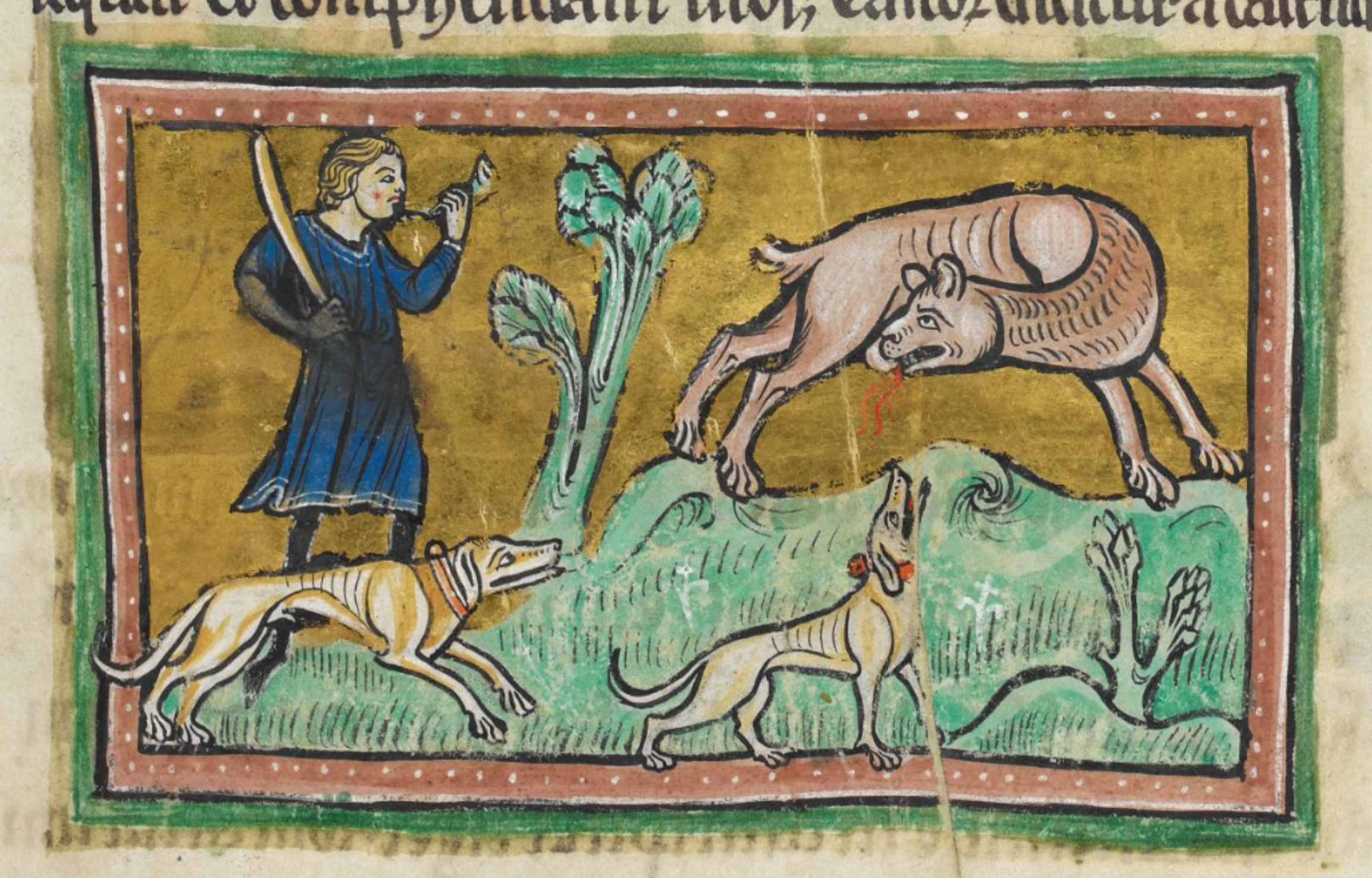
Beaver, Rochester Bestiary, c.1230
Search page
Search within this page here, search the collection page or search the website.
Elephant, Rochester Bestiary, c.1230
Ibex, Rochester Bestiary, c.1230
Beaver, Rochester Bestiary, c.1230
The beaver is an animal whose testicles are used for medical purposes. There is a substance called castoreum that is collected from the glands of mature beavers that is used to treat anxiety, insomnia and menstrual cramps but there is no scientific evidence that supports this theory. Such substance was believed to cure diseases such as epilepsy and to cast evil spirits from the head as well as neutralize the venom of snakes and scorpions.

In Classical times and Christian symbolism, the beaver was often associated with purity, celibacy and chastity. Good Christians ad priests were encouraged to observe these practices in order to devote themselves fully to God. In Matthew 19.12, Jesus mentioned the eunuchs who observed such habits: “For there are eunuchs who were born that way, and there are eunuchs who have been made eunuchs by others—and there are those who choose to live like eunuchs for the sake of the kingdom of heaven. The one who can accept this should accept it.” Besides, the priests of Cybele, the Galli1, also castrated themselves to devote themselves fully to the Goddess.
Every man who wanted to live by the Law of Good was encouraged to castrate himself allegorically to devote himself to God fully, just the same as the beaver does. Allegorically meant that men were urged to free themselves from vices and acts of impurity in order to observe divine precepts.
F14r
nimis. Cuius testiculi medicine sunt aptissimi.
de quo dicit philosogus. quia cum venatorem se inse-
quentem cognoverit; morsu testiculos sibi abscidit;
et in faciem venatoris eos proicit. et sic fugiens evadit;
Si vero rursus contigerit. ut alter venator eum prosequa-
tur; erigit se que et ostendit virilia sua venatori; Quem
cum viderit testiculis carere ab eo discedit. Sic omnis
qui iuxta mandatum dei versat et caste vult vive-
re; secat a se omnia vicia et omnes inpudicie actus.
et proiciat a se ea in faciem diaboli. Tunc ille videns
eum nil suorum habentem; confusus ab eo discedit; Ille
vero vivit in deo et non capitur a diabolo qui dicit. Per-
sequar et comprehendam illos; Castor dicitur a castrando;
The beaver is an extremely gentle animal whose testicles are used for medical purposes. In the Physiologus, it is written that when a beaver realises it is being hunted, it bites off its testicles and throws them in the hunter’s face. Therefore, it survives by escaping. If it is chased again by another hunter, it stands on two legs and shows its genitals to the hunter. When the hunter sees that it lacks testicles, he leaves. Thus, he who lives according to the Law of God and wants to live chastely, will cut off from himself all vices and all acts of impurity and throw them in the face of the devil. Then, the devil, upon seeing that the man has nothing of his own, will leave, confused thereby. He who lives in God and is not captured by the devil says, 'I will pursue and apprehend them.'2 The name castor for beaver derives from the verb castrāre (to castrate).
Bibliography
David Badke, The Bestiary Blog: Animals in the Middle Ages, Beaver, November 6 2023, https://bestiary.ca/beasts/beast152.htm
Josh Goldenberg (BA 2012) and Matt Shanahan (BA 2014, Logeion, November 2022, https://logeion.uchicago.edu/
WebMD LLC, Castoreum - Uses, Side Effects, and More, 2005-2023, https://www.webmd.com/vitamins/ai/ingredientmono-315/castoreum
Castiglioni, L. and Mariotti, S. (1996). Vocabolario della Lingua Latina: Latino-Italiano Italiano-Latino. Terza Edizione. Loescher Torino
Matthews, J. and Matthews C., (2010), The Element Encyclopedia of Magical Creatures, HarperCollins UK, London
Curley, M. J., Physiologus: A Medieval Book of Nature Lore (University of Chicago edition 2009)
Rackham, H., M.A., Pliny Natural History Volume III, Libri VIII-XI (London: William Heinemann Ltd, 1949)
Collins, A. H., M.A., Symbolism of Animals and Birds (New York: McBride, Nast & Company, 1913)
Henderson, C., The Book of Barely Imagined Beings (London: University of Chicago Press, 2013)
White, T. H., The Bestiary: A Book of Beasts (New York: G.P Putnam’s Sons, 1960)
Barney, S. A., Lewis, W. J., Beach A., Berghof O., The Etymologies of Isidore of Seville (New York: Cambridge University Press, 2006)
Footnotes
1 The Galli were eunuch priests of the Phrygian Goddess Cybele and her consort Attis. They used to wear women’s clothes and castrated themselves to devote themselves fully to the Goddess. https://en.wikipedia.org/wiki/Galli
2 It might be referring to Psalm 17:38: “I will pursue my enemies and apprehend them. And I will not turn back until they have failed”.
